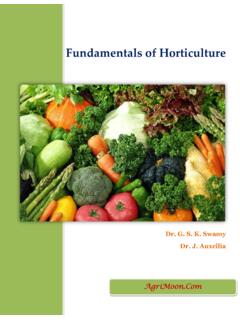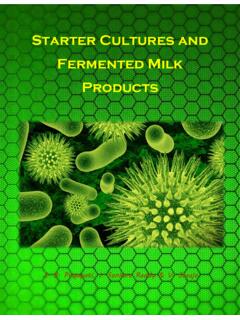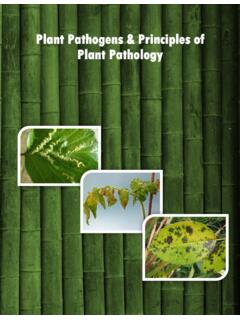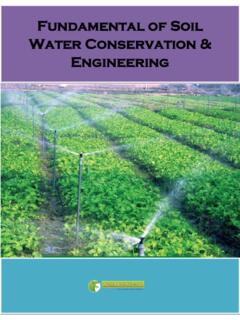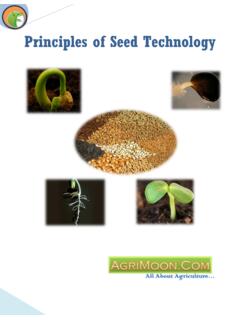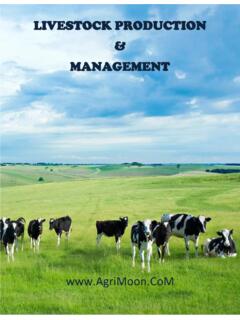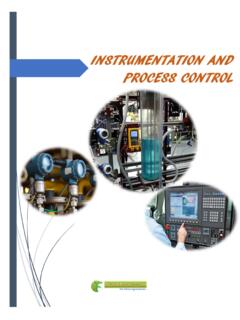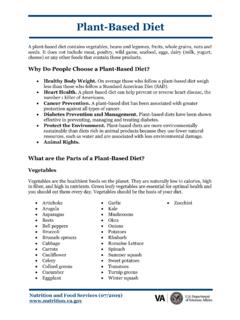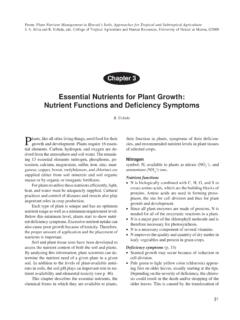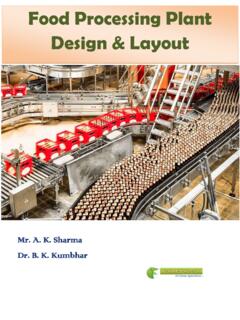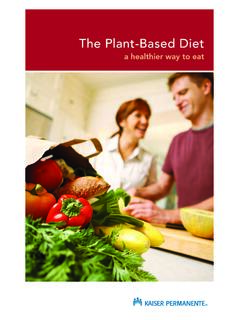Transcription of DAIRY PLANT DESIGN AND LAYOUT - AgriMoon
1 DAIRY PLANT DESIGN AND LAYOUT Sunil M. Patel Bhadania DAIRY PLANT DESIGN and LAYOUT 2 DAIRY PLANT DESIGN & LAYOUT Course Developers Sunil M. Patel & Bhadania Department of DAIRY Engineering AAU, Anand Editor DAIRY PLANT DESIGN and LAYOUT 3 Course Outline 3 (2+0+2) Module 1. Introduction of DAIRY PLANT DESIGN and LAYOUT Lesson of Dairies and Perishable nature of milk Lesson of DAIRY PLANT DESIGN Lesson Procurement Lesson Reception Lesson lassification of DAIRY plants Module 2. Location and Site Selection for DAIRY plants Lesson6. Location of DAIRY PLANT and Types of Locations Lesson of Fluid Milk PLANT and Milk Product PLANT Lesson Selection Lesson 9.
2 Location of Milk Product PLANT Module 3. Planning and principles of DAIRY PLANT LAYOUT Lesson of planning and principles of DAIRY PLANT DESIGN Lesson 11. DAIRY building planning Lesson of process schedule Lesson requirement for DAIRY PLANT Lesson of service requirements including peak load consideration Module 4. DESIGN aspects of DAIRY PLANT Lesson points of consideration for designing DAIRY PLANT Lesson types of layouts Lesson 17. Single or multilevel DESIGN Lesson accommodation Lesson 19. Arrangement of different sections Lesson 20. Service pipe-line LAYOUT Lesson LAYOUT DAIRY PLANT DESIGN and LAYOUT 4 Lesson of offices and workshops Lesson 23. Material handling Lesson of detail LAYOUT with model planning Lesson Problems Module 5.
3 Building construction materials and type of building construction Lesson hoice of building construction materials - Brick, sand, cement, lime etc. Lesson materials stones, wood, metal, glass etc. Lesson 28. General requirement of DAIRY floors and floors for different sections Aspects of Foundations, Roofs, Ceilings, Walls, Doors and windows Lesson and drain LAYOUT for small and large dairies Lesson , Illumination and fly control Lesson , coatings and mold prevention DAIRY PLANT DESIGN and LAYOUT 5 Module 1. Introduction of DAIRY PLANT DESIGN and LAYOUT Lesson 1. Types of Dairies and Peris hable nature of milk Introduction Since India is the leading country in milk production in the world at a fast rate, it has been lead to a need of very scientific LAYOUT and planning for the dairies being set up by the DAIRY designers, engineers and architects.
4 In some organized sectors, milk collection and chilling of milk is done, before it is transported for processing at DAIRY factory. The DAIRY technology commences with processing of milk at DAIRY PLANT for market milk and various DAIRY products. The DAIRY PLANT LAYOUT and DESIGN means designing a LAYOUT plan for DAIRY PLANT . LAYOUT of various sections in DAIRY building, equipment LAYOUT , laying of DAIRY machines in each section for economical and efficient movement of men and material in the PLANT . Milk and milk products, however, impose certain requirements which do not occur elsewhere in food or other industries. These special requirements affect the structure and the LAYOUT of the building, the provision and distribution of services and the choice of site.
5 The products of DAIRY industry milk for liquid consumption, yoghurt, curd, cream, butter, ghee and similar products, cheese, milk powder and so on- are foods which play a fundamental part in human nutrition. Materials and methods used in building must be such as to give the longest practical life with the minimum of maintenance, in spite of working conditions which are often relatively severe from both the mechanical and chemical point of view. It should also be seen that most of the repairs, alterations or extensions could be done without stopping the production. These characteristics demand closest attention during planning. There is a need for highest standard of hygiene. Milk is most suitable medium for the growth of microorganism, therefore every possible measure should be taken to reduce the possibility of contamination, especially after processing.
6 A good LAYOUT DESIGN and use of proper materials and techniques make great contribution towards hygiene. The DAIRY LAYOUT needs careful thought and planning keeping in view manufacture of the products and their commercial aspects. Peris hable nature of milk Milk by its nature is perishable. The following three factors contribute to its being perishable: (i) Contamination with bacteria due to widely dispersed and unhygienic collection methods (ii) Warm temperatures of tropical climate (iii) Prolonged time before cooling or processing In practice, none of these factors can be eliminated completely, so if any one is accentuated, the life of milk will decrease. Therefore, every effort must be made to minimise these factors on the farm, during collection at milk PLANT and during distribution to consumers.
7 At the farm, the aim must be to cool milk as soon as possible after milking. Ideally, the milk should be chilled to 4 C within two hours after milking. If for any reason this can not be done at farm, quick transport of milk to the PLANT is essential. If milk can be stored conveniently at the farm or local collecting depot at low temperature, the organization of transport to milk processing PLANT is simplified to greater extent by transporting bulk quantity in insulated tankers. The type, size and number of vehicles DAIRY PLANT DESIGN and LAYOUT 6 necessary are, therefore determined not only by the usual factors such as distance or nature of roads but also by the condition of milk production.
8 When the milk is drawn from the udder of the milch animals (cows, buffaloes, goat, sheep, etc.), the quality of milk is almost sterile. The milk has its own anti-microbial system present which is active till 2 to 3 hours of milking. The components in milk such as lacto-peroxidase system, immunoglobulins, lactoferrin, etc. have the anti-microbial effect. The perishable nature of milk comes into picture with the contamination from air, human, and milking utensils. The temperature of milk during milking is equal to body temperature , 37 C. The milk being very rich in nutrients such as carbohydrates, fats, proteins, minerals, vitamins and water, becomes good media for the growth of micro-organisms. So the milk should be immediately sent to the dairies within 2 or 3 hours of milking, before it gets sour.
9 If the DAIRY is very far away from the milk collection area, it should be chilled to below 10 C in the bulk milk coolers at the farm level (village co-operatives and/or chilling centres) so that the microbial activity is inactivated. Types of Dairies: ** ** DAIRY PLANT DESIGN and LAYOUT 7 Lesson 2. Importance of DAIRY PLANT DESIGN Introduction: DAIRY PLANT DESIGN , involves the estimation of capacity, process scheduling and proper LAYOUT so as to achieve the objective of handling milk at the least cost and greatest safety. However, the DAIRY industry and the PLANT DESIGN has to meet certain special requirements and need to be focused on these.
10 The following are the few aspects that make the DAIRY industry as a unique one. Special C haracteristics of DAIRY Industry: 1. Perishable nature of milk: Milk is one of the most perishable of the agricultural commodities, and has only few hours of shelf life unless it is chilled and processed. Hence, the TIME factor is the most important aspect to be involved in the DAIRY PLANT DESIGN and lay out 2. Milk is an essential commodity. It provides nutrition especially to children and aged. Hence the DAIRY industry has a high profile in the society, and its functioning is very essential to the well being of the society. 3. Seasonal nature: The DAIRY industry has to deal with availability of raw milk fluctuations depending on the season.
